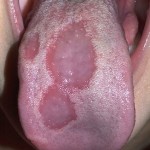
Psoriasis is chronic inflammatory disease with an autoimmune basis which causes symptoms on the skin and sometimes the joints. Worldwide estimates of prevalence varied widely from 0.5% to 11.4% in adults with current UK estimates suggesting between 2-3% are affected. Geographic tongue (benign migratory glossitis) is characterised by smooth areas on the top and sides of the tongue due to an absence of filiform papillae. It has been estimated to be present in up to 8.5% of the population and a link between geographic tongue and psoriasis has been suggested.
The aim of this review was to assess the prevalence of geographic tongue in psoriatic and non-psoriatic patients.
Methods
Searches were conducted in the PubMed, Embase, Web of Science and Cochrane databases. Only case-control studies were included with two reviewers selecting studies. Core data items were extracted and prevalence of geographic tongue in psoriatic and non-psoriatic patients compared with odds ratios (OR) and 95% confidence intervals (CI) recorded for each study. Clinical forms of psoriasis were also analysed: plaque-type vs non- plaque-type, and erythrodermic vs non-erythrodermic.
Results
- 11 studies involving a total of 12,327 patients (2881 cases, 9446 controls) were included.
- 6238 participants were female (50.6%), and 6089 were male (49.4%)
- 292 psoriatic patients and 492 controls had geographic tongue.
- Average prevalence of geographic tongue in the case groups = 10.13% (range, 5.67% – 18.1%).
- Average prevalence of geographic tongue in the control groups = 5.2% (range, 0.88% – 9.0%).
- Random effects meta-analysis shows that the odds of having geographic tongue in patients with psoriasis was higher OR = 3.53 (95%CI; 2.56-4.86) [ 11 studies].
- There were no significant differences between the presence of geographic tongue and the clinical form.
- However, the Psoriasis Area and Severity Index (PASI) score was statistically higher in patients affected by geographic tongue in three of four studies.
- Psoriatic patients with geographic tonguealso exhibited less improvement in the PASI score after treatment.
- One study found an association between geographic tongue and a negative impact on patients’ quality of life.
- Age, gender, toxic habits, psoriasis onset and duration of the disease were not clearly associated.
Conclusions
The authors concluded: –
This is the first meta-analysis that confirms the association between psoriasis and geographic tongue. The result supports the concept of geographic tongueas a manifestation of psoriasis. Additionally, it also suggests that the presence of geographic tongue may indicate a greater severity of the disease and a worse treatment response. Future studies should focus on the repercussions of geographic tongue in psoriatic patients.
Comments
While the authors report that the PRISMA process has been followed details are missing. For example, it is not clearly stated if study selection and data extraction have been conducted independently by two reviewers and using the Newcastle Ottawa Scale for case control studies for the quality assessment of the individual included studies would have been more helpful than the GRADE assessment for individual studies presented. As all the included studies are observational in nature my understanding is that the individual studies would start at a GRADE rating of low and adjusted accordingly. While the review findings suggest an association between psoriasis and geographic tongue a majority of the included studies (6) use a case: control ratio of 1:1 and more information is required on the quality of the included studies particularly the selection and recruitment of the controls.
Links
Primary Paper
González-Álvarez L, García-Martín JM, García-Pola MJ. Association between geographic tongue and psoriasis: A systematic review and meta-analyses. J Oral Pathol Med. 2019 May;48(5):365-372. doi: 10.1111/jop.12840. Epub 2019 Feb 27.Review. PubMed PMID: 30739339.
Other references
Dental Elf – Sep 26th 2018
